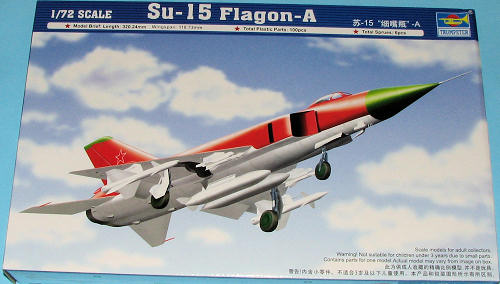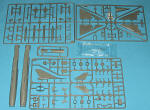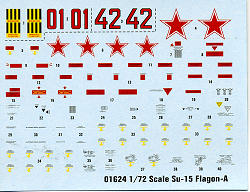
Trumpeter 1/72 Su-15 "Flagon A"
| KIT #: | 01624 |
| PRICE: | $33.95 ($20.35 on sale at GreatModels) |
| DECALS: | Three options |
| REVIEWER: | Scott Van Aken |
| NOTES: |

| HISTORY |
Recognizing the limitations of the earlier Su-9 and Su-11, the Sukhoi OKB quickly began the development of a heavily revised and more capable aircraft. A variety of development aircraft evolved, including the T-49, which shared the fuselage of the Su-9 (including its single engine), but used cheek-mounted intakes to leave the nose clear for a large radome for the 'Oriol-D' (Eagle) radar, and the T-5, essentially a heavily modified Su-11 with a widened rear fuselage containing two Tumansky R-11 engines.
These led to the T-58, which combined the twin engines with a modified version of the T-49's nose, but with side inlets further back, behind the cockpit. It was approved for production on 5 February 1962, as the Su-15, and the prototype first flew on 30 May, 1962. It entered service testing 5 August, 1963, but its service entry was delayed by political infighting with the Yakovlev OKB over production line capacity in Novosibirsk, which was also building the Yakovlev Yak-28P. The Su-15 proved to be superior in most respects other than range, and it was officially commissioned on 3 April 1965. Series production began the following year, and it entered service with the PVO in 1967, replacing Su-9s, Su-11s, and Yakovlev Yak-25s. The initial Su-15 received the NATO reporting name 'Flagon-A.' A simplified trainer version, the Su-15UT (NATO 'Flagon-C'), with no radar or combat capability, entered service in 1970. This particular kit is of the initial production version.
Initial delta wing Su-15s had poor take-off and landing characteristics, and so Sukhoi investigated a new wing design with extended wingtips (increasing wing area) and boundary layer control. Su-15s with the new wing went into production in 1969. They were dubbed 'Flagon-D' by NATO, although the Soviet designation was unchanged.
Also in 1969 testing began of the upgraded Su-15T with the Volkov Taifun (typhoon) radar. The Taifun proved troublesome, however, and ceased production after only 10 aircraft had been built. It was followed in December 1971 by the Su-15TM (NATO 'Flagon-E'), with the improved Taifun-M radar and provision for UPK-23-250 gun pod or Molniya R-60 short-range missiles. Aerodynamic demands forced a redesign of the radome with an ogival shape, earning a new NATO reporting name, 'Flagon-F,' although again the Soviet designation did not change. A comparable combat-capable trainer, the Su-15UM (NATO 'Flagon-G'), followed from 1976. The final Su-15UMs, the last Su-15s produced, came off the line in 1979.
Various OKB proposals for upgraded Su-15s with better engines and aerodynamics were rejected in favor of development of the MiG-23 interceptor.
| THE KIT |
 This is not the first Su-15 to be kitted in 1/72. I can recall at least two vacuform kits and perhaps one or two resin and short run injected kits over the years. None of them were easy to build nor very popular. One reason is probably that the Su-15 is best known in the West for shooting down a Korean Airlines 747, killing all aboard. Though it seems macabre, that aircraft is one of the marking options.
This is not the first Su-15 to be kitted in 1/72. I can recall at least two vacuform kits and perhaps one or two resin and short run injected kits over the years. None of them were easy to build nor very popular. One reason is probably that the Su-15 is best known in the West for shooting down a Korean Airlines 747, killing all aboard. Though it seems macabre, that aircraft is one of the marking options.
Trumpeter's molding is now a known quality. A lot of work has gone into making the engraved panel lines and the fastener detailing. All of it is well done and consistent. There is really nothing in the way of molding flaws or glitches. No ejector pin marks on the inside of the gear doors or on missile bodies as one so often finds with other kits.
You get a reasonable cockpit with a tub, control stick, instrument panel and bang seat. All fairly well done. The canopy is a two part affair that you could pose open if you wished. There is wheel well detailing and the landing gear legs are nicely done. Trumpeter has already decided for you that you want the two fuselage drop tanks and the wing pylons fo r the missiles as molded those holes for you. I'm not up on Soviet missiles, but there are two small dog-fighting missiles for the inner pylon and two large radar guided missiles for the outer wings. Molding is very nice on these.
r the missiles as molded those holes for you. I'm not up on Soviet missiles, but there are two small dog-fighting missiles for the inner pylon and two large radar guided missiles for the outer wings. Molding is very nice on these.
Instructions are up to Trumpeter's usual standards with nicely done construction drawings and Gunze paint references. From the look of things, the wheelbase is long enough so that you don't need nose weight as none is suggested. The nicely done decal sheet has markings for three aircraft. One is the box art plane from a display team with red upper surfaces and unpainted metal undersides. Not sure if this plane would have been carrying anything under the wings or fuselage for the demonstration. The other is a rather standard looking unpainted metal aircraft with the bort Red 42 on the nose. Another has Red 01 and a black and yellow design on the intake splitter. There are many warning decals for these planes.
| CONCLUSIONS |
A friend of mine has been suffering for a considerable time on the 1/48 kit. This one does not look like it has been downsized from that and should prove to be a decent build. We'll see as this kit is on its way to its next victim.....errr.....an eager builder so stay tuned.
| REFERENCES |
October 2008
You can get this and many other superb kits and accessories at www.greatmodels.com
If you would like your product reviewed fairly and fairly quickly, please contact the editor or see other details in the